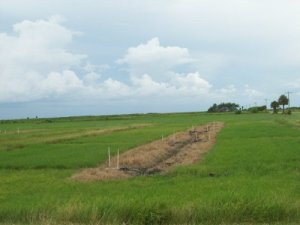Cleaning up Phosphorus-Enriched Soils with Hay Production

Phosphorus (P) and nitrogen (N) concentrations in forage plant tissue occur in the ratio of about 1 P: 8 N (wide ratio), whereas, their ratio in cattle manure is of the order of 1 P: 2 N (narrow ratio). As a result, forage plants tend to absorb and utilize relatively more N than P when manure is repeatedly land-applied for pasture production and the excess P tends to accumulate in soils. Excessive P accumulation and subsequent runoff of soil P are linked to periodic algae blooms and degradation of natural ecosystems in Florida, which could impact recreational use of surface waters such as Lake Okeechobee. A key objective of the Lake Okeechobee Protection Program is to develop and implement environmentally sound and cost-effective P-remediation programs.
Most programs adopted so far aim at binding the excess soil P tightly in the soil with chemical amendments, such as water treatment residuals, so that the P does not migrate off site. It is important, however, that other P-remediation approaches be included that will mine the excess soil P off P-enriched sites.
Pasture production is the largest land use option in the region surrounding the Lake Okeechobee Basin in Florida. Typically, water from a dairy wastewater withholding lagoon is used to irrigate grass for hay production and grass yield and quality increase with increasing rate of N-fertilization. At UF/IFAS, we have been investigating for the past two years the P-mining potential of several warm season grasses used for hay production in the Lake Okeechobee Basin with cooperation from a local commercial Dairy operation. The objectives of these studies were to determine the effects of N-fertilization rate on 1) forage production, forage quality, and forage P-removal; 2) changes in residual soil-P; and 3) leaching and runoff of both nitrate and soluble P from the experimental site.
We applied 0, 45, 60 and 90 lb of N/A from ammonium nitrate to stands of bahiagrass, stargrass and limpograss on manure-impacted sites at the Dairy under rain-fed conditions in 2004 and 2005. Overall soluble soil-P in the top soil layer during spring of 2004 was 25, 26, and 21 ppm Melich-1 P for bahiagrass, limpograss and stargrass pastures, respectively. Each N treatment was applied to a plot size measuring 25 x 50 ft and we used 4 replications of each N treatment on each grass. Potassium was applied according to soil test results but no P fertilizer was applied. Bahiagrass and stargrass forage was harvested to a 4-inch stubble every 30 days whereas limpograss forage was harvested to an 8-inch stubble every 45 days. At each harvest, forage samples were collected for dry matter content, crude protein, in vitro organic matter digestion and tissue P concentration determinations. Plots were cleaned and re-fertilized with the same N-treatments after each harvest. The entire study was repeated in the 2005 growing season. In 2004 and 2005, there were a total of seven harvests for bahiagrass and stargrass, and five harvests for limpograss each season.
Seasonal forage dry matter yield increased from 4.3 to 9.2 T/A for bahiagrass, 4.7 to 8.8 T/A for limpograss and from 5.0 to 8.0 T/A for stargrass as N rate was increased in 2004. Corresponding yields in 2005 season were 3.8 to 7.1, 3.9 to 9.2, and 2.2 to 4.6 T/A for bahiagrass, limpograss and stargrass, respectively. Total P harvested, calculated as forage dry matter yield x tissue P concentration increased with N-fertilizer rate from 33 to 56 lb/A for bahiagrass, 28 to 46 lb/A for limpograss and 26 to 30 lb/A for stargrass in 2004 season. The maximum P removal at the highest N application rate corresponds to annual P2O5 removal of 126, 104 and 68 lb/A for bahiagrass, limpograss and stargrass, respectively. Laboratory analysis of tissue P concentration for 2005 samples have not been completed. Based on initial and end of 2004 season soil sampling results, forage production resulted in an overall reduction in Melich-1 soil P of 7 to 13 ppm as N rate was increased for bahiagrass pasture. Corresponding decline in soil P were 4 to 9 ppm for limpograss and 5 to 13 ppm for stargrass. Both forage crude protein and digestibility showed positive responses to increasing N rate for all grasses in 2004. Increasing N rate did not result in a significant increase in nitrate concentration of groundwater collected from run-off samplers or deep wells but did increase nitrates in water from shallow wells. The dissipation of nitrates with increasing water depth may be related to both crop uptake and denitrification, commonly observed under anaerobic conditions in saturated spodosols. The study is continuing in 2006 for long-term information but results up to date imply that hay production may provide a viable strategy for reducing residual soil-P of P-enriched sites.

